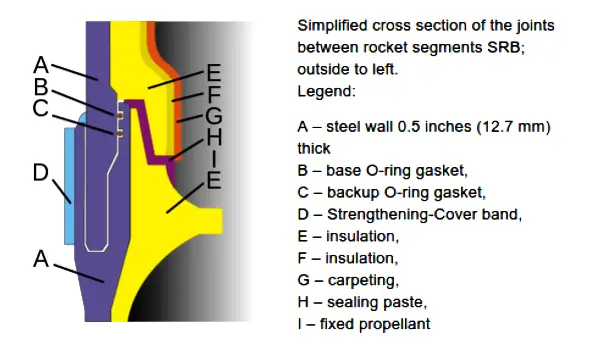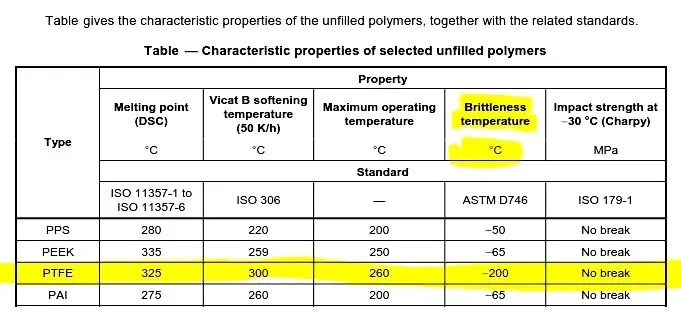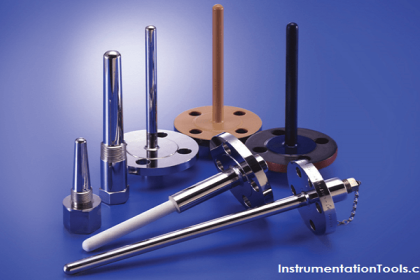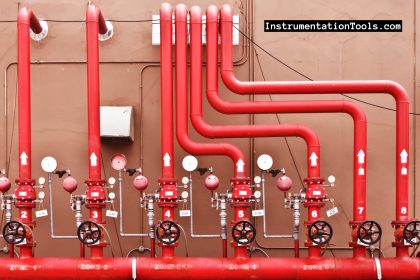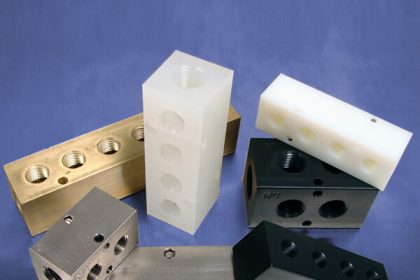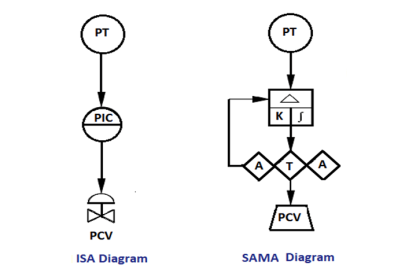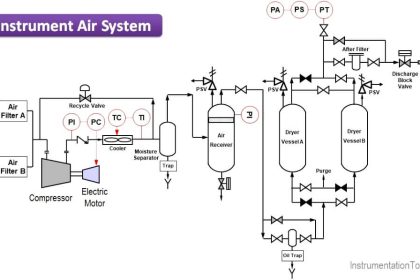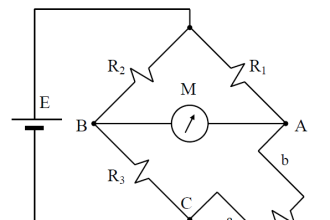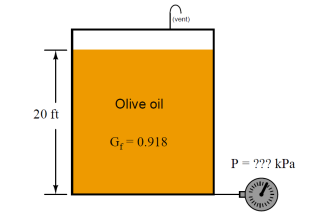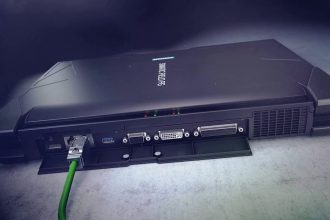The “Technical” Story :-
Below you can see Violet Part which is the Steel wall
The Gray part is Fixed Propellant.
In simple words these make the shuttle motor (Refer Pic below)
Now B is Primary O-Ring ,And C is Secondary O-Ring.
These O-Ring form a seal and don’t allow hot gases to come out. From that purple portion !
Interesting thing is for all previous launch this same construction worked but this time something different happened.
What always happened was called “Ballooning”.
In Simple words, At high temperatures (2,760 °C) , the metal parts of the casing bent away from each other, opening a gap through which hot gases—above 2,760 °C leaked
This happen for all rocket launch, So why didn’t other rockets blast ???
This had occurred in previous launches, but each time this happened, The primary O-ring had shifted out of its groove and formed a seal.
Although the SRB (the above picture) was not designed to function this way, it appeared to work well enough, and Morton-Thiokol (The contractor) changed the design specs to accommodate this process, known as extrusion.
Everything went good for many launches then ………………….One Fine Day was the launch of NASA’s Challenger.
What happened this time was after 17 sec of launch the Space shuttle exploded and it was into thousands of pieces, Like it didn’t exist!!!!!
During this Launch a crucial factor was cold weather
The Night Before the launch, Temperature had dropped down to -8°C
The next morning Ice had accumulated and team of people cleared it .
Now there is something called as “Glass Transition temperature”
“Glass Transition Temperature”
When an O-ring is cooled below its Tg (glass transition temperature), it loses its elasticity and becomes brittle.
Interesting Question is What happens when you are near Tg ?
When an O-ring is cooled near, but not beyond, its Tg, the cold O-ring, once compressed, will take longer than normal to return to its original shape.
And as we know O-rings (and all other seals) work by creating positive pressure against a surface thereby preventing leaks and This was famously demonstrated physics professor Richard Feynman, when he placed a small O-ring into ice-cold water, and subsequently showed its loss of flexibility before an investigative committee that this was the caused that at crucial need the O-ring could not seal at the right time !
Also Note the O-Ring used for Space shuttle is FKM Vitton.
This is a widely used O-ring in our Petroleum & chemical industry too !!!!
With Little more Engineering Knowledge we can save lives of people at plant and Billions of dollars!!!
So what are the Technical lessons we can learn ?
DON’T ONLY CHECK UPPER TEMPERATURE LIMIT.
We usually only check the Upper Temperature limit of O-Rings and Gaskets
Like for Example for PTFE the upper temperature is 260 °C.
But there is also the Lower temperature that must be checked .
This is sometimes called “Glass Transition temperature” or “Brittleness Temperature” or “Lower Temperature limit”
Below is a screen shot from ISO 23936-1:2009
Yellow highlighted is “Brittleness Temperature” for PTFE
Yes, PTFE has a very low Brittleness Temperature but not all materials !!
Also as we learn from this accident is don’t keep lingering around this glass transition temperature
when an O-ring is cooled near, but not beyond, its Tg, the cold O-ring, once compressed, will take longer than normal to return to its original shape.
CHEMICAL COMPATIBILITY
Few Examples of What must not be used for a particular service
Polyether-etherketones (PEEK)
Hydrogen sulfide can attack PEEK, specifically in the presence of amines and elemental sulfur and at high partial pressures and temperatures in the range of 200 °C
Limited chemical resistance exists also against halogenated hydrocarbons ( O-Ring selection standard ISO 23936-1:2009 Page 10 )
Now,My Personal Favorite the O-Ring used above in NASA’s Shuttle Motor FKM Vitton
FKM Vitton
This is an amazing O-ring material acceptable to many services but still there are few service where it is not compatible
FKM is not acceptable for Amines or hot water and steam ………..(API RP 551…..PAGE 15)
And STEAM is used in Majority of plants !!!
We cannot predict how a Elastomer will fail some swell, some dissolve, and some take a compression set.
Explosive Decompression (ED) can occur when an elastomer absorbs process vapor and the pressure is abruptly released.
A seal can become damaged as a result and will be unable to hold pressure afterwards
Polytetrafluoro-ethylene (PTFE)
The temperature limit is 260 °C. At this temperature, the mechanical properties are very poor due to creep. Stress corrosion cracking has not been observed with PTFE.
No media used in oil and gas production, including functional chemicals (detergents, surfactants, emulsifiers, demulsifies and corrosion inhibitors), have been reported to attack PTFE up to the temperature limit.
………………(O-Ring selection standard ISO 23936-1:2009 Page 11)
But Obviously the standard does not hold any responsibility of compatibility but it gives us a good guide line in selection.
Hence stay safe and refer Standards :-
1) ISO 23936, Non-metallic Elastomers for Oil and Gas Production
2) EN 682, Non-metallic Elastomers for Oil and Gas Production,
Also consult with manufacture in case you find something that needs further clarification !!!
Also, During initial start up of plant it is better to not start activity at extreme cold and hot temperatures!!
Thanks for Reading !!!
Hope this was helpful, Even if in a small way !
Reference for incident details
1.https://en.wikipedia.org/wiki/Space_Shuttle_Challenger_disaster
2.https://en.wikipedia.org/wiki/O-ring
PS : As always this is as per best of my current understanding and I have tried my best to give reference from the standards I have referred during preparation of this article, but in case I have missed something, I would be very grateful and happy to know if there are corrections or updates required.
Author : Asad Shaikh
Profile : Linkedin
